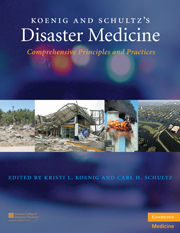Book contents
- Frontmatter
- Contents
- List of Contributors
- Contributor Biographies
- Foreword
- Preface
- Acknowledgments
- PART I CONCEPTUAL FRAMEWORK AND STRATEGIC OVERVIEW
- 1 Disaster Research and Epidemiology
- 2 Disaster Education and Training: Linking Individual and Organizational Learning and Performance
- 3 Surge Capacity
- 4 International Perspectives on Disaster Management
- 5 Ethical Issues in Disaster Medicine
- 6 Emerging Infectious Diseases: Concepts in Preparing for and Responding to the Next Microbial Threat
- 7 Disaster Mental and Behavioral Health
- 8 Special Needs Populations
- PART II OPERATIONAL ISSUES
- PART III CLINICAL MANAGEMENT
- Index
- Plate section
- References
6 - Emerging Infectious Diseases: Concepts in Preparing for and Responding to the Next Microbial Threat
from PART I - CONCEPTUAL FRAMEWORK AND STRATEGIC OVERVIEW
Published online by Cambridge University Press: 05 August 2011
- Frontmatter
- Contents
- List of Contributors
- Contributor Biographies
- Foreword
- Preface
- Acknowledgments
- PART I CONCEPTUAL FRAMEWORK AND STRATEGIC OVERVIEW
- 1 Disaster Research and Epidemiology
- 2 Disaster Education and Training: Linking Individual and Organizational Learning and Performance
- 3 Surge Capacity
- 4 International Perspectives on Disaster Management
- 5 Ethical Issues in Disaster Medicine
- 6 Emerging Infectious Diseases: Concepts in Preparing for and Responding to the Next Microbial Threat
- 7 Disaster Mental and Behavioral Health
- 8 Special Needs Populations
- PART II OPERATIONAL ISSUES
- PART III CLINICAL MANAGEMENT
- Index
- Plate section
- References
Summary
INTRODUCTION
Former U.S. Surgeon General William H. Stewart has been attributed with stating in the late 1960s that the time had come to “close the book” on infectious diseases as major threats to public health. Even though the statement's authenticity has been called into question, it is often used to convey the optimism widely expressed at the time by health experts and world leaders. Indeed, it did appear that the age of infectious diseases that had plagued humans for millennia was coming to an end. Vaccines and antibiotics had substantially reduced the incidence and mortality of many diseases. The smallpox eradication campaign was on its way and it was thought that eradication of other diseases (for example tuberculosis and polio) would not be too far behind. Improved food and water safety resulted in less exposure to disease-causing microbes, and the use of pesticides to control arthropod populations had reduced vector-borne diseases. It seemed the battle with the microbial world had been won and it was time to focus efforts and funding on the looming threat of chronic diseases.
Of course, this confidence largely ignored the burden of infectious diseases in the developing world. Four decades later, although great strides have been made to control infectious diseases, microbial pathogens are still major threats to public health throughout the world. The last few decades have ushered in new challenges: “old” pathogens once thought to be controlled by antibiotics have developed multidrug resistance, new pathogens have emerged, and traditional pathogens have appeared in new places.
Keywords
- Type
- Chapter
- Information
- Koenig and Schultz's Disaster MedicineComprehensive Principles and Practices, pp. 75 - 102Publisher: Cambridge University PressPrint publication year: 2009
References
- 2
- Cited by



